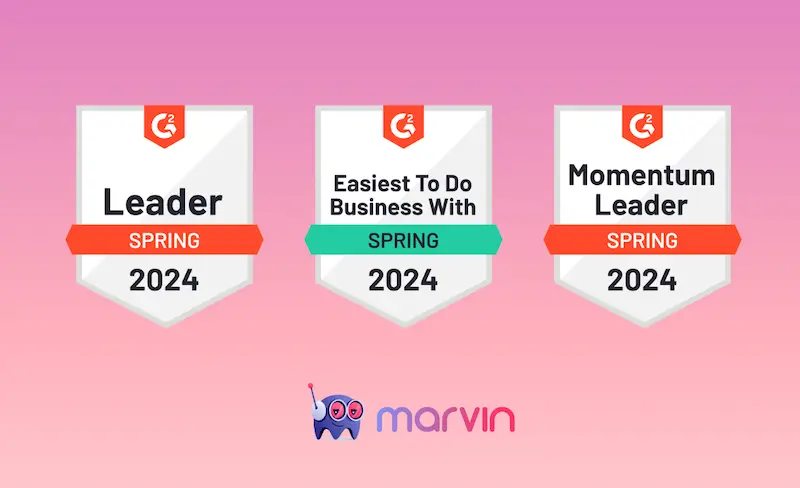Don’t hop on the AI train without a destination in mind. Here is a playbook for introducing AI into your UX analytics strategy.
Following these guidelines will help you ensure widespread adoption and future-proof your company’s AI-readiness.
Let’s jump in.
Define Goals and Objectives of Your UX Analytics Strategy
What do you want to measure?
We gave a bit of a preamble in part one of this series. Jump back to “AI in UX Analytics: The Data You Need to Make User-Centric Choices” to decide which metrics to use for your UX analytics strategy.
And don’t pick just one. Track many to get a holistic view of the user experience. Research which data is necessary to improve usability and customer adoption. Tie core business goals to the metrics that you’ll track and measure.
Apply the SMART (or any other) framework to every goal. Each must be Specific, Measurable, Achievable, Relevant and Time-based.
UX Design Leader Brian Verhoeven shared his process for setting goals and metrics. Success for him means always keeping the company vision in mind as you build out your strategy.
Identify Areas of AI Application
How can AI help in data collection and analysis?
AI is helpful during all stages of the UX research journey. During brainstorming, use story mapping to visualize and anticipate the potential user path. Break it down into smaller tasks. Create initial prototypes for validation. Use it to draft questions for surveys.
AI can assimilate data from various sources. Leverage its immense processing power to analyze large datasets.
Identify tools that measure KPIs aligned with business objectives from above. Ideally, they must integrate seamlessly with a company’s existing technology stack. Standout tools also help guide you through the process.
Soft Launch Your New UX Analytics Strategy
Begin with a small-scale project for proof of concept. Minimize resource use for this pilot project. This lets you evaluate the ROI potential of the AI technology. Prototype work flows to evaluate the quality of answers & research outcomes.
Measure both qualitative and quantitative metrics. A mix of both ensures you get usability statistics, and the underlying reasons WHY certain events are taking place. This gives you a well rounded understanding of UX roadblocks and user pain points.
Use the pilot as an opportunity to obtain baseline data. It establishes the reference point that you can build upon. Start small, then scale up.
Act on UX Insights
AI helps you sift through oceans of data to focus on the most pressing usability issues. Quantitative data gives you the big picture and identifies recurring problems. Qualitative data offers detailed supporting insights for these problems.
Organize and tag usability issues according to their severity (e.g. critical, high, medium, low). This helps developers develop (yup, we said it!) a sense of urgency. After coding any solutions or product updates, launch in-app surveys and feedback collection. Use real-time metrics to make product or feature adjustments quickly.
AI analytics help organizations stay agile and competitive.
Share AI Insights
Create an environment that’s conducive to using AI insights effectively. Build AI awareness and knowhow across your organization. Make it a team-wide effort. Share insights with peers and colleagues. Help them understand the gravity of dealing with sensitive user data.
Create an ethics charter for appropriate data usage(more on this below). Establish guidelines and best practices for ethical AI use. Ones that emphasize fairness, transparency and accountability.
Become the collaboration station.
Learn Continuously
Keep up to date with current AI developments. Engage with AI tech providers and researchers. Stay at the forefront of advancements in AI technologies.
Address skill gaps by conducting training and workshops. Promote AI literacy by including employees both technical and non-technical.
Investing in new talent and building out a company’s AI capabilities is vital.
How to Navigate the Challenges of Using AI in UX Analytics
Like all new technology, AI comes with its own set of challenges.
Encountering teething problems is inevitable, given AI’s nascent stage of development. Don’t forget to pay heed to these potential stumbling blocks. We’ve also identified some implementable solutions and workarounds. Keep these in mind when working with AI in UX analytics…
Data Privacy & Security
Below, we cover how AI will help create personalized and tailor-made user experiences. Companies amass terabytes of user data. However, they must strike a balance between personalization and privacy.
Data must be collected, stored and used ethically. A user’s personally identifiable information (PII) safeguarded. Ensure compliance with data protection guidelines such as SOC2 and GDPR (Marvin checks these boxes). Where possible, anonymize data and obtain data collection consent from users. Follow ethical best practices to establish customer trust. With Marvin, your user data is always protected.
Inherent Bias
Bias is everywhere. You can’t escape it. Humans build machines. And humans have inherent biases.
All AI is trained on publicly available, biased datasets. This bias trickles down into the algorithms used in AI technology.
Algorithmic Bias occurs when AI systems favor user groups and marginalize certain others. This bias eventually filters into research outcomes. It can lead to inaccurate predictions or discriminatory output. This renders final data unusable.
Designers must remain vigilant. Begin by implementing measures to mitigate bias and treat all users fairly and equitably. Easier said than done.
You can learn more about the different types of biases here. Then head over to this helpful playbook from UC Berkeley to help mitigate them.
Lack of Human Touch
Designers must balance automation with human intuition.
You can automate many stages of analysis. Over automation strips away the human touch that makes design empathetic and relatable. AI may overlook the finer details. Ones associated with creativity and human intuition possessed by a designer. AI doesn’t replace a human’s emotional understanding and creativity. Humans help connect the dots. How does research impact a company’s goals?”
With AI automation, there tends to be an overemphasis on metrics without any context. That’s where a human comes in. It’s essential to combine qualitative and quantitative metrics for a holistic view. Analyze metrics with behavioral data or user feedback to derive more meaningful conclusions.
The Black Box
AI algorithms continually learn from new data. However, HOW they arrive at a decision or their decision making process is unknown.
As AI systems become more sophisticated, there’s a need for transparency and explainability. It’s essential to make the AI algorithms decision making process more transparent to users. They must be able to understand how AI shapes the user experience. And they must have the ability to challenge decisions made by AI.
With so much debate about the black box, a new field called Explainable AI (XAI) has emerged.
Data Issues
Users often have complex journeys across multiple touch points.
To simplify and understand user pathways, use journey mapping tools or visual aids. Conduct user interviews and collaborate with UX/UI designers. Create user flow diagrams to visualize and grasp user journeys better.
AI is capable of assimilating large amounts of data. However, deriving meaningful insights from collected data is another story.
To assemble data in a usable format, use APIs or data connectors to merge data from multiple sources. Choose a platform that integrates with existing tools and caters to centralized data collection.

Interpreting qualitative data from user feedback can be tricky for machines (and humans!). Machines must analyze qualitative data using structured frameworks or methodologies. After conducting AI-enabled analysis, fact check with UX experts. This ensures data accuracy.
Now that you have a handle on what to look out for, let’s dive into the various tools that use AI to assist with UX analytics.
Integrating AI in UX Analytics
One UX analytics tool just won’t cut the mustard. You need a host of complementary tools to track the various metrics (as outlined in part one of this UX Analytics series).
Each tool’s functionality will vary widely. However, here are some common desirable features to look out for:
- Reliability. No crashes. A tool with clear and concise reporting.
- Ease-of-use. No complexity. Must be effortless for technical & non-technical folk.
- Practicality & Cost-effectiveness. Requires less time and few resources to set up.
- Compatibility. Integrates seamlessly with a company’s existing tool stack.
AI eliminates the need for the manual assimilation of data. This enables companies to continuously glean user data, charting a history of their actions on a platform.
For collecting UX Metrics with AI, we’ve listed different types of tools below. Bear in mind that each method provides limited insight. They don’t entirely explain user behavior and motivations while using an application:
In-Page Web Analytics
These applications track user activity on a website. Tools such as Google Analytics are widely used by businesses across the globe. They use AI to analyze large amounts of quantitative data. This helps highlight trends and potential issues.
What features are your users engaging with? Apart from in-page analytics, GA tracks user specific actions. These include clicking a button, purchasing something or submitting a form.
Embedded user feedback widgets establish a continuous feedback loop. Whether they encounter a good or bad moment, it allows users to give feedback on specific parts of the experience.
Web analytics tools use AI to help segment user data. Automate reporting and get real-time insights to improve decision making.
User Journey and Funnel Analytics
The moment a potential customer runs into a wall, they’re likely to abandon a product.
Conversion Funnels analyze the user journey. They monitor new and returning visitors. Funnel analytics tools show you the stages at which user flow friction and churn occur. They measure conversion rates and identify user drop-off points. Powered by complex algorithms, AI helps websites make dynamic recommendations that increase the likelihood of conversion.
Conduct a retention analysis to observe customer churn. Designers can identify where there’s a drop-off and address any usability issues with the app. Such obstacles include bugs or a misleading UX.
User journey mapping enables businesses to visualize and analyze the user’s interaction from start to finish. It uncovers pain points and helps designers optimize the user experience.
A word of warning. These tools do NOT capture qualitative user feedback. They don’t explain WHY users abandon a product.
Heatmaps
What UI elements are drawing attention? Which ones are being ignored? Heatmaps visualize exactly where a user’s attention is. Study the following metrics to see where you can improve your interface:
- Scrolls
- Clicks
- Hovers
- Move
- Engagement zones
- Text inputs
- Rage clicks (a user clicks repeatedly on a spot in a website or application expecting something to happen. A surefire way to spot a bug or a bad element in the UI)
Heatmaps are a visual representation of user interactions. While they’re easy to interpret, they may not fully capture the user context.
Usability Testing
Usability testing is usually conducted in person or remotely. Moderators watch and guide a group or individual users through the process. They interrogate users for their feelings as they go through the application.
This provides insight into how customers experience a product. It also helps designers identify what changes to make to facilitate product adoption.
To learn more about the future of AI in user testing, head over to our in-depth exploration.
Session Recordings
Walk in the user’s shoes. Watching session replays helps you understand the user journey.
Designers can unearth problems such as rage clicking, broken links, misleading messages, lack of CTA, etc.
Again, AI helps identify patterns in raw data. It helps spot friction points and can generate a summary of the session. This is super helpful when analyzing large amounts of data. Session Recordings offer in-depth insights. However, that data has to live somewhere. Either locally or on the cloud.
Seems like another good time to mention Marvin… Marvin integrates with all the tools designers know and love. Marvin is the research repository of choice for UX professionals.
Visualizing UX Metrics
UX analytics is most effective when everyone in an organization uses data to make decisions.
Create a UX analytics dashboard that’s accessible to all the relevant stakeholders. Here are some tips for creating an effective dashboard:
- Place the important metrics on top.
- Don’t overwhelm viewers. Display no more than 3-5 metrics.
- Tie metrics to business goals.
Anyone who quickly glances at the dashboard must get a sense of how the business is doing. Dashboards enable colleagues to engage with user data. It allows users to extract knowledge without enlisting the help of additional data analysis tools.
Tools such as Tableau & Power BI help you connect to multiple data sources. Visualize complex datasets with AI. Both applications include AI features that help you assemble data and dashboards with ease. Quickly identify trends, patterns, and anomalies to make insights actionable.
More advanced tools can create:
- Forecasts. Predict future trends based on historical data. Extends the chart to offer insight into what happens next (with estimated error bands).
- Clusters. Helps establish categories. Makes identifying patterns in the data easier.
- Key Drivers. Identify factors that significantly impact an outcome or variable. They explain what drives an increase or decrease in a specific metric. This helps researchers understand relationships between variables, guiding decisions and actions.
Further, AI chatbots use NLP to help you interrogate the data. Chat to unearth business insights, explain complex data visualizations, or create analytical aids on the fly. This makes analytics more accessible to startups and enterprises who don’t have technical expertise, as it removes the need for complex querying
With a plethora of options available, it’s wise to thoroughly evaluate the tools you’re considering. Conduct a comparative analysis of tools. Utilize free demos to get hands-on and establish a sense of what complements your business best.
The Future of UX Analytics with AI
What does a future with advanced AI have in store for us?
AI technology is advancing rapidly. Embracing AI allows companies to optimize internal processes. Harnessing the data analytics capabilities, researchers and designers can now make data-driven decisions.
Using AI in decision making will become a key differentiator for organizations in the future. AI helps unearth insights on a scale previously unheard of. This brings efficiency to the UX analysis process so firms can strengthen their market position. Firms who adopt AI analytics will hold a significant competitive advantage over those who don’t.
AI analyzes user behavior round the clock. Designers understand their users on a deeper level. This enables them to constantly innovate and create new solutions. Companies can take on a more customer-centric approach.
Tailor-Made User Experiences with AI
Here are some ways in which AI will create unique user experiences:
- AI will personalize user experiences at scale. Designers can now understand a multitude of customer needs at every stage of the user journey. They’ll continually adapt and refine user profiles, creating dynamic user personas. Catering to these detailed personas increases a product’s personalization.
- AI has predictive capabilities. With the ability to foresee user interactions, designers can create intuitive user experiences. Anticipatory changes lead to an optimization of the user experience. Proactively addressing user needs fosters a deeper connection with users. This breeds deep customer loyalty, and can differentiate a company in a crowded marketplace.
- AI will redefine the way users interact with content. Using detailed user data results in more engaging user interfaces. Throughout their interactions, users receive relevant content and functionality. AI facilitates seamless interactions across various touch points. Users feel immersed in a product that feels made exclusively for them.
The future is full of personalized, user-centric designs. And AI will help us get there.
Future AI Capabilities
Imagine a future where AI informs researchers about an increase or decrease in a metric. Algorithms will not only identify these trends. They’ll explain the underlying cause behind why it happened. One step further, AI will recommend actions to optimize performance.
A truly autonomous system.
Designers and researchers running many campaigns will let AI do their bidding. AI algorithms can monitor multiple workstreams. They’ll report which ones are performing best and recommend steps to optimize apps further.
While creating new assets, AI can recommend launch plans. It’ll leverage historical trends and market performance to guide future efforts.
Snapback to reality.
It’s important to acknowledge that AI is at a nascent stage of development. It’ll be a while before AI analytics becomes truly autonomous.
For that to happen, machines need to have a tight grasp on what:
- is requested. The ability to comprehend common queries and understand relational data requests. Must also have the ability to ask users for additional contextual information.
- happened. They’ll need situational data and contextual metadata.
- is important. Need well structured and sufficient data about user history and the market conditions.
- to do about it. AI must rate or grade all potential outcomes. It must include risks and rewards in its evaluation.
A long way to go, then.
But AI will continue to be a crucial part of your UX analytics strategy. It’s inevitable.
Photo by Hunter Harritt on Unsplash





